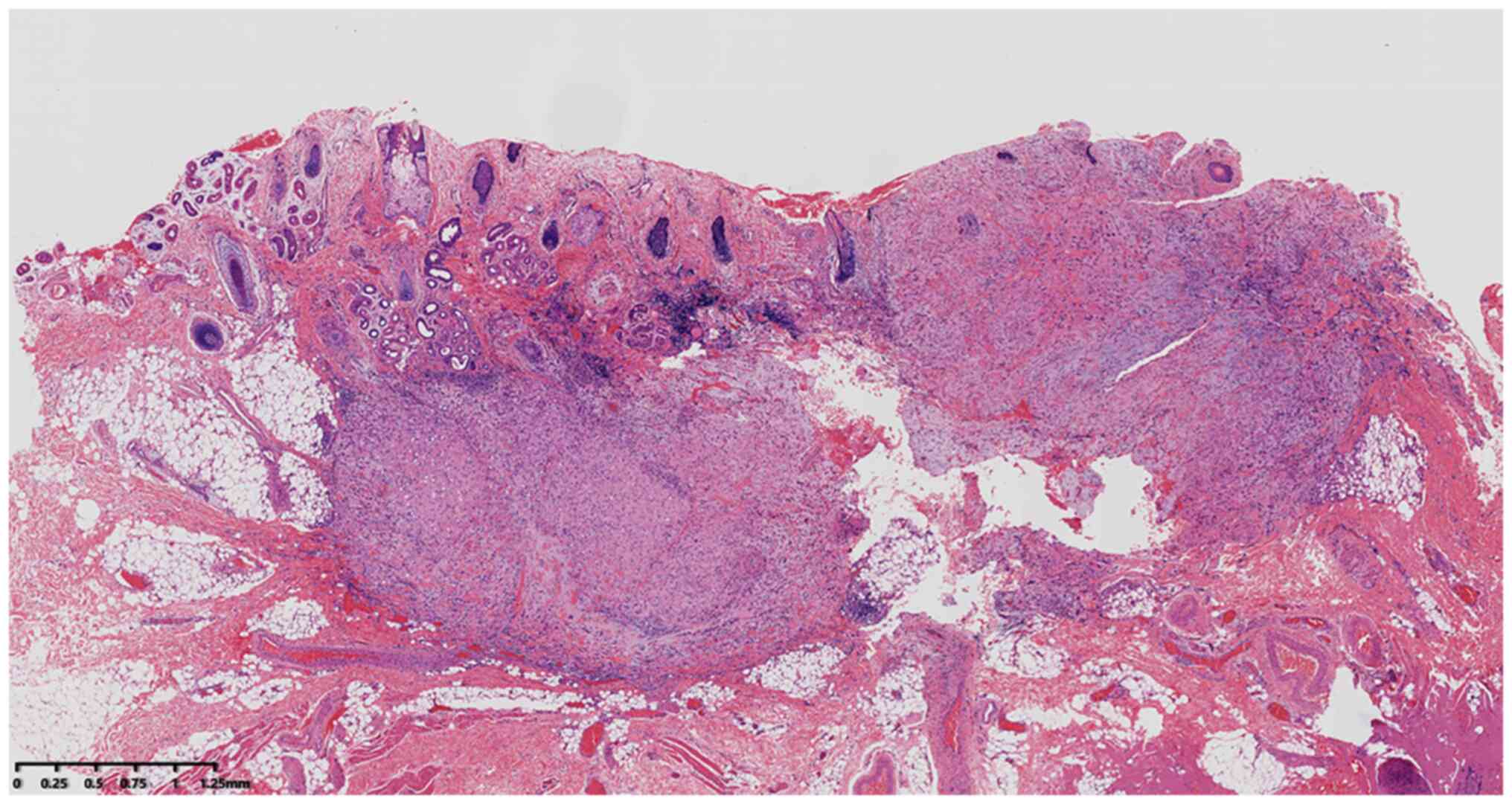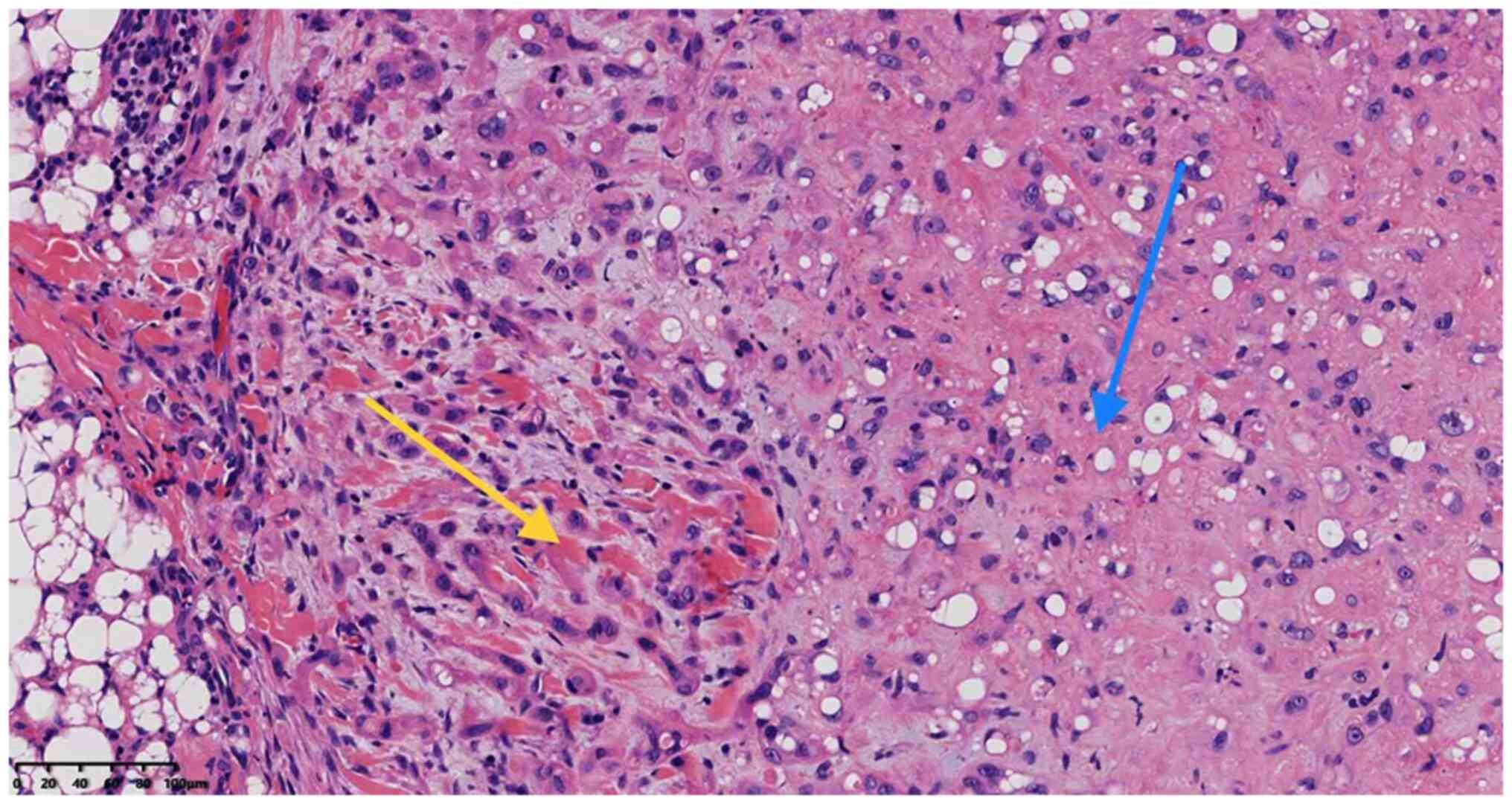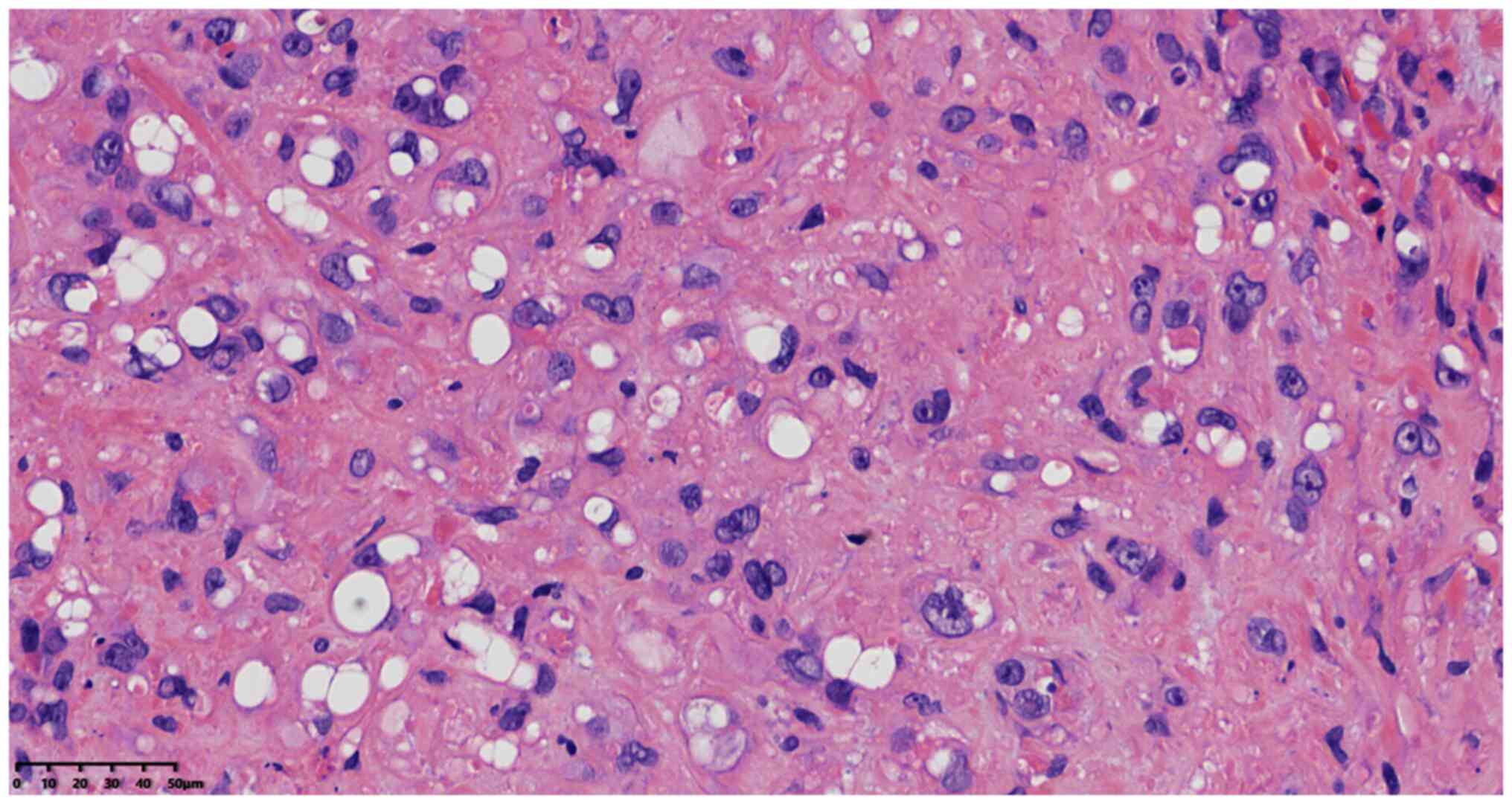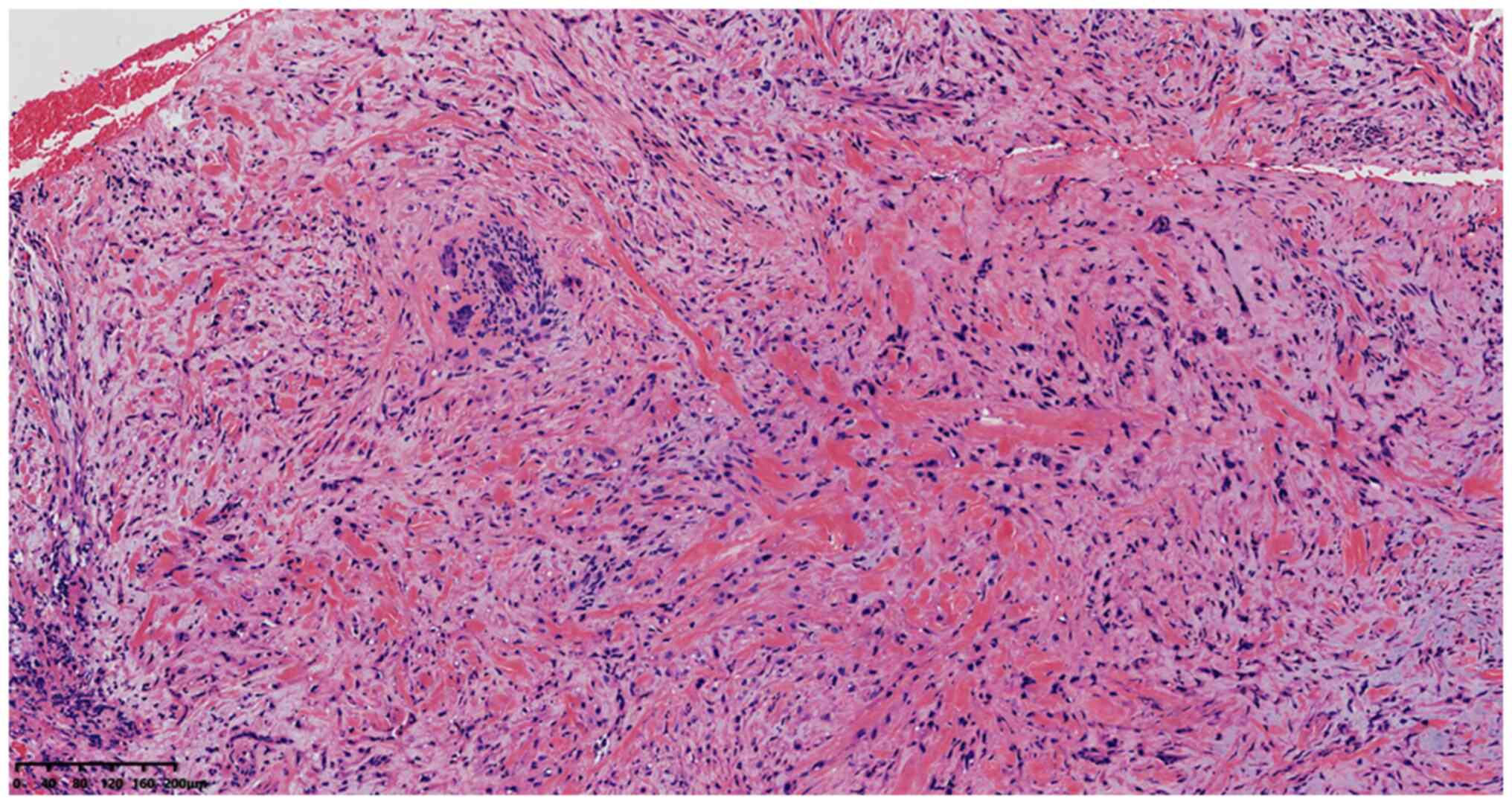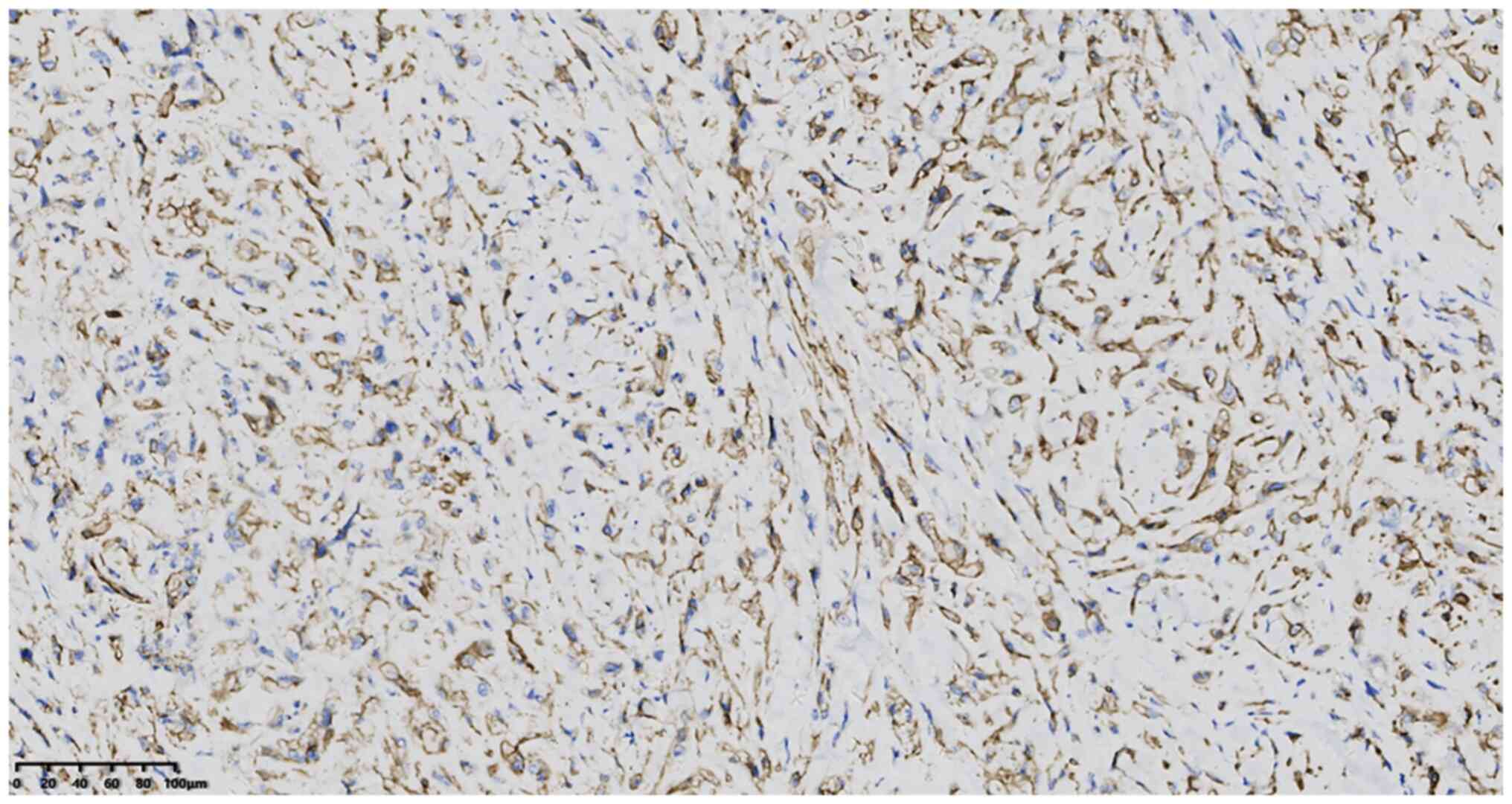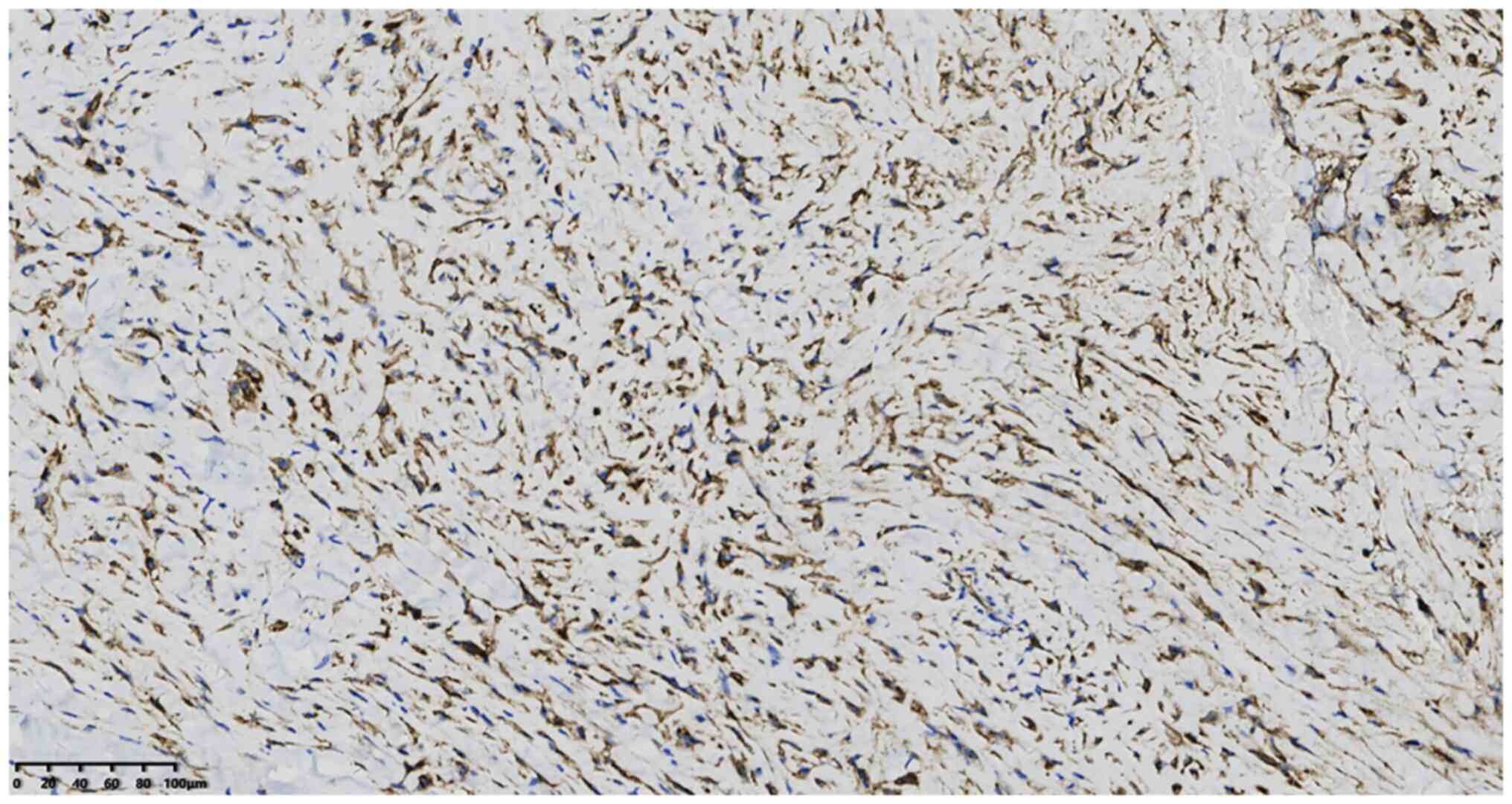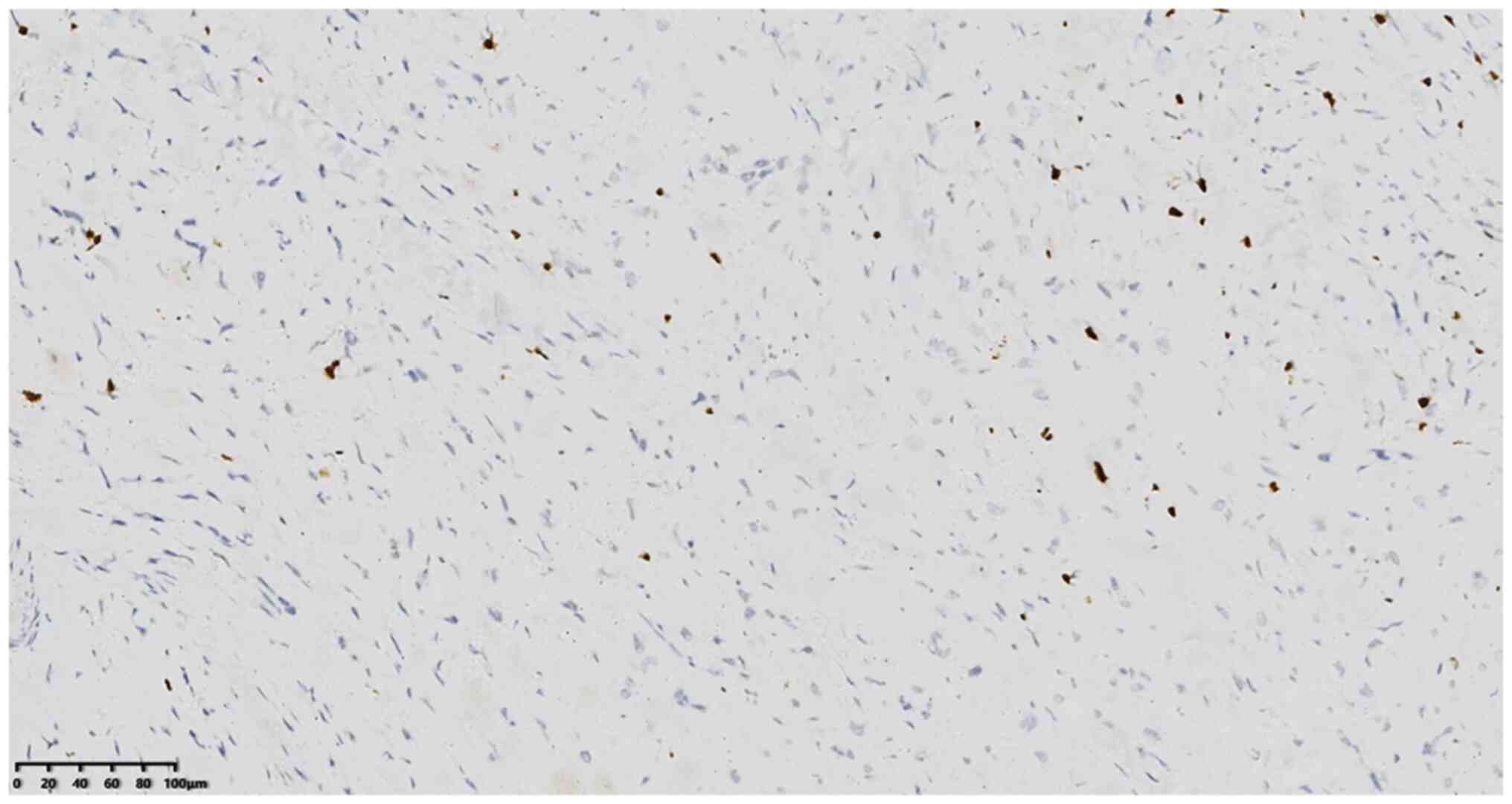Primary epithelioid hemangioendothelioma of the eyelid: A case report
- Authors:
- Published online on: September 21, 2022 https://doi.org/10.3892/ol.2022.13518
- Article Number: 398
-
Copyright: © Chen et al. This is an open access article distributed under the terms of Creative Commons Attribution License.
Abstract
Introduction
Epithelioid hemangioendothelioma (EH) is a vascular endothelial cell neoplasm of low malignancy. In 1982, Weiss and Enzinger (1) reported a group of vascular tumors occurring in the surrounding soft tissues that they termed EH. Since 2002, the World Health Organization (WHO) has classified EH as a malignant tumor (2,3). EH occurs in the superficial or deep soft tissues of the limbs, liver, lungs and bones, among others, and rarely occurs in the orbit and/or eyelid (4,5). EH can occur at any age, with cases occurring in patients between 13 and 86 years old, with a median age of ~50 years. EHE occurs slightly more often in women, especially in the lungs and liver. The overall 5-year survival rate for patients with the neoplasm is 73% (2). Since Tsuji et al (6) first reported EH of the eyelid (EHE) in 2010, four cases have been reported in studies published in English (6–9). Microscopically, the tumor consists of proliferating epithelioid and fusiform vascular endothelial cells, and the atypia of epithelioid and spindle cells is not obvious. These cells form a mass of primitive blood vessels and the lumina contain red blood cells. The local cytoplasm of the tumor cells is obviously vacuolated, and immunohistochemistry shows positive expression of CD31 and/or CD34. In one case, the tumor cells in the eyelid were involved with the lacrimal glands (8). Current EHE treatment is based on extensive tumor resection with a negative margin.
Case report
Patient
In January 2022, A 10-year-old girl was admitted to the Department of Ophthalmology of the First People's Hospital of Xiaoshan District (Hangzhou, China) due to a painless red mass in the left eyelid that had been present for 6 months.
Physical examination
The left upper eyelid mass was ~1.0×0.6×0.3 cm in size, with a red surface. The patient experienced tenderness and normal vision. The blood routine, including liver function, myocardial enzyme profile and coagulation time, was normal. A left upper eyelid cyst was thus clinically diagnosed. After successful local anesthesia, a horizontal incision of ~1 cm was made at the mass site to separate the fascia and muscularum tissue from the surface of the mass. A cystic mass ~1.0 cm in diameter was found. Tobramycin and dexamethasone eye ointment and clonbitone eye drops were given for symptomatic treatment (twice a day, 2 drops each time for 3 days).
Macroexamination
There were two pieces of gray and red soft tissue with a total volume of ~1.1×0.6×0.3 cm. The maximum diameter of gray-red coloration in the section area was ~0.6 cm, The texture of the tissue was soft and no obvious capsule was observed.
Microscopic observation
The tissue was fixed with 4% neutral formalin (24 h at 25°C) and embedded in paraffin, and 4-µm serial sections were prepared that were subjected to hematoxylin and eosin (H&E) staining (8 h at 25°C). At low magnification (digital slice scanner; Ningbo Jiangfeng Biological Information Technology, Co., Ltd.), the tumor showed nodular and solid patchy growth in the dermis and subcutaneous adipose tissue (Fig. 1). No skin accessory recidivity was observed. At high magnification, the tumor cells consisted of epithelioid cells (70%) and spindle cells (30%). The epithelial cells were distributed in the shape of nests and cords, and the cells were round and oval, with some ill-defined boundaries, enlarged nuclei, lightly stained chromatin, partial thick nuclear membrane, nucleoli, no mitotic signs, no obvious atypia, abundant eosinophilic cytoplasm and partial nuclear deviated cytoplasm with signet ring-like or vacuolated changes (Figs. 2 and 3). Red blood cells could be seen in the lumen where the original blood vessels were formed (Fig. 4). Extensive branching and antler-like structures were not seen in areas with high vascular density. Some spindle cells were distributed in a braided shape, and the cells were long and spindle-like, with no abnormal nuclei, hyperchromatic nuclei and no mitosis (Fig. 5). Areas of epithelioid and spindle cells transitioned with each other (Fig. 6). The interstitial area had myxoid degeneration (Fig. 7) and was collagenous. There was no eosinophil infiltration, no necrosis, no vascular and nerve recidivization, and the incision margin was positive.
Immunohistochemical staining with the EnVision Systems method using antibodies from Beijing Zhongshan Jinqiao Biotechnology Co., Ltd., and Fuzhou Maixin Biotechnology Development Co., Ltd., was performed at 37°C for 40 min for all primary antibodies, with the following results: Positivity for CD34 (working liquid; cat. no. 2005270034b) (Fig. 8) and CD31 (working liquid; cat. no. 2104140720b) (Fig. 9), partial positivity for smooth muscle actin (working liquid; cat. no. 21010809), weak positivity for cytokeratin (working liquid; cat. no. 21061509), a negative result for Desmin (working liquid; cat. no. 21011686), epithelial membrane antibody (working liquid; cat. no 21020730), 34βE12 (working liquid; cat. no. 2109090052c4), p53 (working liquid; cat. no. 20082125) and S-100 protein (working liquid; cat. no. 2012240585C8), and a positive result (3%) for the Ki-67 proliferative index (1:200; cat. no. 21030436) (Fig. 10). DAB staining solution (polymer method; KIT-0014) was used at 25°C for 20 min, and results were assessed using a digital slice scanner (Ningbo Jiangfeng Biological Information Technology Co., Ltd.).
Pathological diagnosis
The tumor recurred 3 months after the operation, as the first incision margin was positive. The patient underwent an extended tumor resection 3 months after this first recurrence. This time, the pathological analysis showed EH with a negative margin. The patient is still being followed up after the second operation.
Discussion
EH is a kind of vascular endothelial cell tumor with a low degree of malignancy that was first reported by Weiss and Enzinger (1) in 1982. Since 2002, the WHO has classified EH as a malignancy (2,3). EH occurs in superficial or deep soft tissues such as those of the extremities, liver, lungs and bone, and rarely in the orbit and/or eyelids (4,5). Since Tsuji et al (6) first reported EHE in 2010, to the best of our knowledge, only 4 cases have been reported worldwide (6–9). Combined with the present case, these 5 cases were analyzed in the present literature review.
The age range of EHE, from the literature review cases reported in Table I, is between 10 and 55 years old, the mean age is 29.8 years old and the male to female ratio is 1:4. EHE occurs in a 4:1 ratio of upper and lower eyelids. Clinical manifestations included a mass on the eyelid, painless swelling or mild pain, potentially accompanied by eyelid ptosis. Some of the EHEs had a red or pink raised appearance, and one patient had lost eyelashes (6). Palpation showed small nodules or irregular masses with poor mobility. Some cases were clinically diagnosed as hemangioma, chalazion or cysts. Computed tomography and magnetic resonance imaging showed multiple eyelid tumors extending into the orbit without bone tissue involvement in one case (9). In some patients, other general examinations such as blood routine, liver and kidney function tests, chest radiography and abdominal ultrasound showed no abnormalities.
Pathological examination showed that none of the tissues from the five cases had a capsule, and the sections were pink, reddish, grayish brown, and soft or hard in texture and bleeding. Microscopic histological examination was similar to EH in other soft-tissue sites. The tumor was composed of hyperplasia of epithelial-like and fusiform vascular endothelial cells, and myxoid stroma was seen in two cases (including the present case) (6). Epithelioid cells are round, oval or polygonal whereas spindle cells contain little cytoplasm and some nuclei are hyperchromatic without atypia. These cells form a mass of primitive blood vessels containing one or more red blood cells in the lumen. In one case, tumor cells in the eyelid were involved with the lacrimal glands, and erythrocytes could be seen in the cavity of local cells, with obvious vacuolation of the cytoplasm and occasional mitosis, without atypia, extensive branching or antler-type vessels (8). When comparing the immunohistochemical results, CD31 was positive in 80% of the cases, CD34 was positive in all cases, EMA was positive in one case, factor VIII was focal positive in 1/2 of the cases and the Ki-67 proliferative index was <10%. A molecular genetics study showed that EH had a specific chromosomal translocation of t(1;3)(p36.3;q25) and produced a WWTR1-CAM TAI fusion gene (10), whereas additional studies observed that a small portion of EH cases possessed t(x;11)(pl1;q22), which produced a YAP1-TFE3 gene translocation (11,12). This translocation can be detected by fluorescence in situ hybridization examination or reverse transcription-polymerase chain reaction, as well as immunohistochemistry with CAMTA1 and TFE3 markers (12–14). In the present case, the tumor was composed of epithelioid and spindle cells, with primitive blood vessels and signet ring-like or vacuolated structures. Immunohistochemical studies showed that the tumor cells diffusely stained positive for CD34 and CD31, p53 was negative and the Ki-67 labeling index was 3%. The pathological diagnosis was consistent with EHE.
EHE should be distinguished from the following tumors: i) Epithelioid hemangiosarcoma: The tumor is often characterized by irregular vascular lumens, invasive or destructive growth of neoplastic vessels, obvious cell atypia, large and vacuolated nuclei with obvious nucleoli, and distinguishable mitotic images. ii) Epithelioid sarcoma: Mainly occurs in distal extremities, it is polynodular under the microscope, with obvious necrosis or hyaloid degeneration in the tumor center, obvious epithelioid cell atypia, distinguishable mitotic images, no obvious primitive blood vessels, and cytoplasmic ring-like or vacuolated structures. iii) Poorly differentiated adenocarcinoma: When EH tumor occurs in the pleura, bones and other sites, it is easy to misdiagnose as cancer when the cells are signet ring-like, but the epithelial marker is positive, the vasogenic marker is negative and the primary site can be distinguished. iv) Epithelioid hemangioma: A benign vascular tumor with epithelioid endothelium, also known as vascular lymphoid tissue hyperplasia accompanied by eosinophilia. Endothelial cells are distributed on the lumen surface, and intra-lumen and paravascular surfaces. The tumor may be solid and patchy and is distinguished by interstitial eosinophilia. v) Eyelid sebaceous gland cyst: Clinical palpation of this disease diagnoses a cystic sensory benign lesion and B-mode ultrasound can be used to find the cyst. Pathological examination of the cysts reveals that they contain oil, the cyst wall consists of squamous epithelium and, occasionally, the skin appendage can be seen. vi) Eyelid stye: Eyelid gland infection caused by eyelid swelling with diffuse pain. Some indurations caused by infection are palpable and some are not. Eyelid styes are generally eliminated with anti-inflammatory medication.
EH treatment is based on an extensive tumor resection to ensure a negative margin. Chemotherapy and radiotherapy are also recommended, but the efficacy of radiotherapy and chemotherapy is not optimal (15). The overall 5-year survival rate for EH is 73%. It occurs in soft tissues, with a local recurrence rate of 10–15%, a metastasis rate of 20–30%, mainly to the regional lymph nodes, lungs and liver, and a mortality rate of 10–20% (2). In the literature review, three cases of EHE underwent surgical resection and no recurrence or metastasis was observed at the 14–44 month follow-up periods (6–8). Ennouhi et al (9) reported a case of recurrence due to a positive surgical margin twice, but no recurrence or metastasis was found in the 60 months of follow-up after the third surgical resection.
In conclusion, EHE is a rare low-grade malignant tumor, and its diagnosis needs to be confirmed by pathology and immunohistochemistry. We believe that a negative margin should be ensured after the pathological diagnosis of EHE is confirmed in the surgically resected specimens. If the margin is positive, the resection should be expanded in time to prevent recurrence. Since EHE is rare, its clinical, pathological and therapeutic outcomes need to be further explored.
Acknowledgements
Not applicable.
Funding
Funding: No funding was received.
Availability of data and materials
The datasets used and/or analyzed during the current study are available from the corresponding author on reasonable request.
Authors' contributions
LC and BH drafted the manuscript and conceived the study. HL and FH were responsible for the collection and analysis of case data and literature. BH, JY and HL revised the manuscript and interpreted the data. BH and HL confirm the authenticity of all the raw data. All authors read and approved the final manuscript.
Ethics approval and consent to participate
Not applicable.
Patient consent for publication
The mother of the patient provided written informed consent for the case study to be published.
Competing interests
The authors declare that they have no competing interests.
References
|
Weiss SW and Enzinger FM: Epithelioid hemangioendothelioma: A vascular tumor often mistaken for a carcinoma. Cancer. 50:970–981. 1982. View Article : Google Scholar : PubMed/NCBI | |
|
Wang J and Zhu X: Pathology of soft tissue tumor [M]. 2nd Ed. Beijing: People's Medical Publishing House; pp. 809–819. 2017, (In Chinese). | |
|
Fletcher CD, Unni KK and Mertens F: WHO classification of tumours. Pathology and genetics of tumours of soft tissue and bone. IARC Press; Lyon: 2002 | |
|
Zaragoza-Herrera A, Morales-Baños DR, Velasco-Ramos P, Garrido-Sánchez GA, López-Hernández CM and Borbolla-Pertierra AM: Case report: Orbital epithelioid haemangioendothelioma. Arch Soc Esp Oftalmol. 92:pp184–188. 2016. View Article : Google Scholar | |
|
Su F, Ma R, Zhang N, Li YY, Hei Y, Xu X and Yang XJ: A case report of orbital epithelioid hemangioendothelioma. Zhonghua Yan Ke Za Zhi. 57:696–699. 2021.(In Chinese). | |
|
Tsuji H, Kanda H, Kashiwagi H and Mimura T: Primary epithelioid haemangioendothelioma of the eyelid. Br J Ophthalmol. 94:261–262. 2010. View Article : Google Scholar | |
|
Al-Faky YH, Al Malki S and Raddaoui E: Hemangioendothelioma of the eyelid can mimic chalazion. Oman J Ophthalmol. 4:142–143. 2011. View Article : Google Scholar | |
|
Kiratli H, Tarlan B and Ruacan S: Epitheloid hemangioendothelioma of the palpebral lobe of the lacrimal gland. Orbit. 32:120–123. 2013. View Article : Google Scholar | |
|
Ennouhi MA, Guerrouani A and Moussaoui A: Epithelioid hemangioendothelioma, an uncommon tumor of the eyelid: A case report. J Stomatol Oral Maxillofac Surg. 119:40–43. 2018. View Article : Google Scholar : PubMed/NCBI | |
|
Errani C, Zhang L, Sung YS, Hajdu M, Singer S, Maki RG, Healey JH and Antonescu CR: A novel WWTR1-CAM-TAl gene fusion is a consistent abnormality in epithelioid hemangioendothelioma of different anatomic sites. Genes Chromosomes Cancer. 50:644–653. 2011. View Article : Google Scholar : PubMed/NCBI | |
|
Doyle LA, Fletcher CD and Hornick JL: Nuclear expression of CAMTA1 distinguishes epithelioid hemangioendothelioma from histologic mimics. Am J Surg Pathol. 40:94–102. 2016. View Article : Google Scholar | |
|
Puls F, Niblett A, Clarke J, Kindblom LG and McCulloch T: YAPI-TFE3 epithelioid hemangioendothelioma: A case without vasoformation and a new transcript varian. Virchows Arch. 466:473–478. 2015. View Article : Google Scholar : PubMed/NCBI | |
|
Antonescu CR, Le Loarer F, Mosquera JM, Sboner A, Zhang L, Chen CL, Chen HW, Pathan N, Krausz T, Dickson BC, et al: Novel YAPI-TFE3 fusion defines a distinct subset of epithelioid hemangioendothelioma. Genes Chromosomes Cancer. 52:775–784. 2013. View Article : Google Scholar : PubMed/NCBI | |
|
Shibuya R, Matsuyama A, Shiba E, Harada H, Yabuki K and Hisaoka M: CAMTA1 is a useful immunohistochemical marker for diagnosing epithelioid haemangioendothelioma. Histopathology. 67:827–835. 2015. View Article : Google Scholar : PubMed/NCBI | |
|
Lasselin-Boyard P, Olivier Boulet P, Grados F, Sevestre H and Goëb V: Premier casde vertébroplastie pour un hémangioendothéliome épithéliolde. Rev Rhum. 82:137–138. 2015. View Article : Google Scholar |



